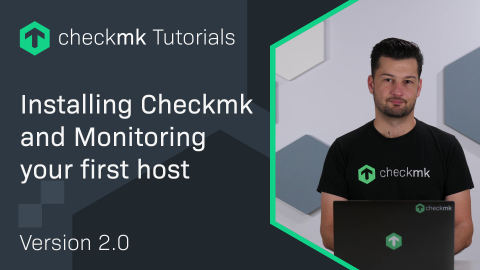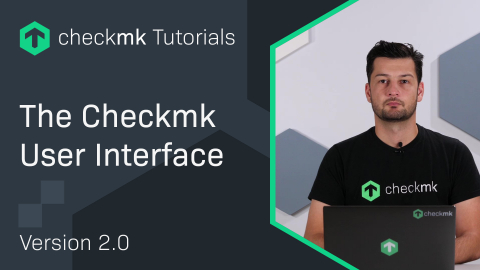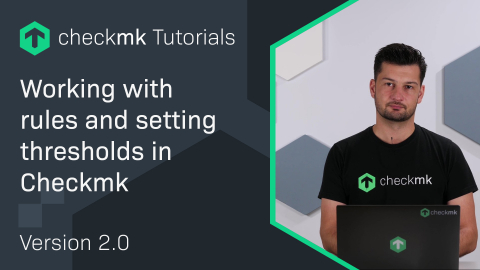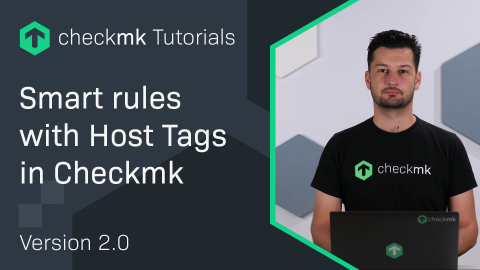Ep. 26: Monitoring Kubernetes with Checkmk
| [0:00:00] | Hello, welcome back to the Checkmk channel. Today we will talk about Kubernetes monitoring. |
| [0:00:15] | Kubernetes is a great tool. It comes with a lot of nice features and also has self-healing capabilities. But it's not just magic. Things at some point will go wrong, things will fail. And for that, you better have monitoring in place. |
| [0:00:29] | With the all new Checkmk 2.1, we bring you all completely new revamped Kubernetes monitoring with a lot of nice features which will make monitoring your Kubernetes clusters a breeze. |
| [0:00:39] | Today, we will take a look at that. So, this is how our Kubernetes monitoring looks like. |
| [0:00:44] | Before we go into actual installation and setup of it, I just want to give you a quick look into the end result what you will get when we are done with a couple of simple steps to go there. |
| [0:00:55] | This is a cluster dashboard which helps you to visualize all the important metrics and health of your applications and workloads in your cluster. |
| [0:01:05] | It's just the beginning of your trip into visibility into Kubernetes. From there on you can actually dive down into individual dashboards. |
| [0:01:14] | For example, you could go down into the Deployments dashboard for the specific deployment which seems to have a problem, where we can see something clearly in red. Hey, there's something wrong. And we could go down here to see what exactly is wrong. |
| [0:01:29] | We could see in the detailed metrics on the deployment, on the Pods belonging to deployment, the problems of this deployment all in one view. |
| [0:01:37] | And now let's go into the next step. How to actually get started with that? |
| [0:01:43] | Okay, let's install the Kubernetes collectors which we need to get the data from your Kubernetes cluster. These Kubernetes collectors you can find on our github repository on the tribe29/checkmk_kube_agent. |
| [0:01:57] | And here you just have to go into the folder deploy, charts/checkmk. Because here you will also find the documentation how to install it. |
| [0:02:06] | For the installation, you need a recent Kubernetes version, 1.19+ is quite old so you should be able to fulfill that as a prerequisite and you need helm as a tool. |
| [0:02:17] | Helm is basically a package manager for Kubernetes. First thing we do is we add the repository. I take this command. |
| [0:02:29] | I give the repository a name. I call it tribe29 and it has been added. The next thing I need to do is I need to update my repository. Simple command, and done. |
| [0:02:48] | Okay, so we just updated the helm repository. And before we go into the next step of actually installing the Kubernetes collectors, we will get a file called values.yaml. |
| [0:03:00] | Yeah, you can find it up here. It helps you to configure your Kubernetes collectors. It simplifies that quite a lot. You can specify If you want to have TLS communication enabled. |
| [0:03:14] | You can specify there If you want to have port security policies enabled. And all other nice things in a really easy manner. |
| [0:03:22] | And we will do that by downloading this. I already prepared a command for that. Here let's just download it. And now we have it on our system. |
| [0:03:36] | I will change a couple of values in there to make the Kubernetes collectors exposed to the outside world. Because by default, the Kubernetes collector which we will install is not accessible from the outside. |
| [0:03:53] | But for Checkmk to be able to actually pull the data from your Kubernetes cluster, we have to do so. For that, I go down here until I end up at the service. |
| [0:04:10] | And there are two options which you can use. You can either expose the Kubernetes service of the cluster collector or you can enable an ingress depends how your kubernetes are set up. |
| [0:04:24] | Here I have a very simple Kubernetes cluster. I don't have any ingress that's why I'm going to go for the option of NodePort. So, I just have to specify NodePort here and I uncomment this line. |
| [0:04:40] | And that's the only change I need to do to basically expose my cluster collector to the outside world on that specific port on that node. |
| [0:04:53] | We will not go into how you can execute that for now. That is part for another video. |
| [0:04:57] | And for now this is only internally accessible for me in my internal environment, so it's fine for me to have unsecured communication here. |
| [0:05:06] | But for any productive cluster, I highly recommend to use TLS or to make sure safe communications by using an ingress with the built-in capabilities of that ingress. |
| [0:05:19] | Okay, now we have configured this values.yaml and we can go back into the documentation here and copy this command. |
| [0:05:33] | In this command, we first have to specify the Namespace in which the Kubernetes collector will be installed. I use checkmk-monitoring. Let's give it all the release name. You can do whatever you want, I just choose checkmk. |
| [0:05:49] | And we have to specify the repository and that has to be the same name which I used above, and above I used tribe29. |
| [0:05:58] | And I also passed the values.yaml to overwrite the standard configuration of this helm chart to expose the cluster on the NodePort 30035. |
| [0:06:15] | Okay, let's see what happens. Okay, and the cluster collector was successfully installed and the helm chart also provides us with a lot of useful commands to get started. |
| [0:06:28] | Yeah, these commands are all helpful for you to actually configure the Checkmk connection to the Kubernetes cluster collector. |
| [0:06:37] | Among the first thing is how you can actually access the cluster collector. This is this part. The second part is the tokens and the certificate for the connection towards the cluster collector and the Kubernetes API. |
| [0:06:54] | I will just copy these commands, execute them. And then if I take a look at them, I will be able to see the token which I need for communicating to my cluster and I will also be able to get the ca certificate. |
| [0:07:14] | These are two things which I then need for configuring my Checkmk Kubernetes collector connection in Checkmk. |
| [0:07:21] | Okay, now we have everything what we need to actually configure Checkmk to be able to monitor Kubernetes. I have created a completely fresh site. |
| [0:07:33] | And in this site the first thing which we do is we go to Hosts and add a host for our Kubernetes cluster. Now I call this kube-internal. |
| [0:07:47] | I give this No IP because this is just there for collecting the data. This is basically one host which is the destination for all my data to be located on. |
| [0:08:02] | Next thing which I do is I just think it's just nice is to create one folder where I just put everything. I call it k8s-objects. |
| [0:08:13] | And as next thing is we create a password, we use the password of Checkmk to store the token for the connection to the cluster collector and the Kubernetes API. |
| [0:08:29] | I give this name Kubernetes Internal Token. And now I go to my console, copy the token which I just got before, go back to Checkmk and save it. |
| [0:08:46] | Just a neat thing to have it because now it's encrypted on my disk, which is neat. |
| [0:09:07] | We go here and we add a new CA certificate. We go back to the console. We copy the certificate. Save. And now we have done all the stuff which we need to be able to access it. |
| [0:09:26] | Now you can actually configure the connection. For that, just go to Setup type in something with Kubernetes and we will find here the rule under VM, Cloud, Container, called Kubernetes. |
| [0:09:37] | We can add a rule here. Okay, let's configure the kubernetes rule. The first thing which we need to do is we have to give our cluster a name. I call it internal. |
| [0:09:49] | Then we have to assign a token. We take the one from the password store which we just specified. Next thing is we have to specify the endpoint of the API server. |
| [0:10:02] | If you don't know the IP address or the FQDN of that, look at the configuration of your kubectl tool and you'll find in the kubeconfig there the address of the API server. |
| [0:10:17] | We obviously want to verify the certificate. And this next step we have to enrich the data which we get with the data from the Checkmk cluster collector. |
| [0:10:29] | For that, I use whatever I have specified before and when we deployed the cluster collector into our Kubernetes cluster. I selected NodePort. You can obviously also use ingress. |
| [0:10:41] | And for NodePort, I just have to specify the IP address of one node. That's something which every Kubernetes cluster can do. I haven't enabled HTTPS in production, please do. |
| [0:10:57] | And now we're almost done. We just have to assign this rule to a host. I assign this rule to the kube-internal host and that's it. Let's save the rule, activate it, and then take a look at our hosts. |
| [0:11:22] | So, we have our kube-internal host which we just created and that one. First thing which we do is we look into the Checkmk service discovery and we edit the services. |
| [0:11:36] | And we can already see, hey, it has discovered a couple of things. It has discovered some Kubernetes services. |
| [0:11:44] | We accept them all it's receiving metrics, it's receiving CPU usage of your cluster. The Kubernetes API is live and ready. We see memory matrix. We see how many nodes we have in our cluster and how many pods. |
| [0:12:07] | With that, however, we only have one host in Checkmk now. We obviously want all the pods, all deployments, and all the other things also to appear in Checkmk. |
| [0:12:17] | And for that, we have to activate the Dynamic host management. I create a new connection. I call it Kubernetes. I add here under Piggyback creation options a new element. |
| [0:12:38] | I create the hosts in the folder which I just created. You can choose whatever you want. And I also choose to delete hosts which don't have Piggyback data. |
| [0:12:49] | This Piggyback data mechanism is the way how we get the data from the cluster collector into our Checkmk. |
| [0:12:57] | And we will use this feature to get the stuff in now. And I will restrict the source hosts to my kube-internal because I only want this dynamic configuration to be applied to that specific host. |
| [0:13:16] | Let's save that, activate the changes. And we can already see all the hosts which are being created. |
| [0:13:25] | So, Checkmk itself now is discovering everything in your Kubernetes cluster. All the pods you can see here are being created. |
| [0:13:34] | All the Namespaces, deployments, the immune sets, every object in your Kubernetes cluster is being monitored now. Checkmk will take care of that for you so that you don't have to do that. |
| [0:13:47] | Okay, we can see up here that we have already now 87 hosts in our Kubernetes in our Checkmk monitoring. |
| [0:13:56] | And the first thing which we can do is we can take a look at the Kubernetes dashboards which I showed in the beginning. For that, you go to Monitor and under Applications, you will find Kubernetes. |
| [0:14:14] | In here you can see now our cluster which we just configured with already some metrics. And we can go now into the cluster, dive deep in, and we see the cluster dashboard. |
| [0:14:26] | It's obviously pretty empty at the moment because all the data is being gathered at the moment. |
| [0:14:31] | Let's give it a short moment and take a look at how it looks like in a couple of seconds. |
| [0:14:36] | Okay, and just a couple of seconds later, we have our entire Kubernetes monitoring ready and running. We can see immediately which Namespaces we have, we can see our workloads in here. |
| [0:14:53] | We can sort that if we want to see, okay, which workload has a lot of load in there. We can sort them also by memory consumption to identify the top consumers. |
| [0:15:04] | And I'm gonna disable the sidebar so that we can see it full. The first metrics are already coming in here. |
| [0:15:13] | We can see, okay, this is how the CPU resource is now over a cluster and we can now also go in. We can, for example, say hey, I want to see everything in my Namespace default. |
| [0:15:24] | And we can, for example, check out the Namespace dashboard. You can see immediately which workloads are running directly in default. And then, for example, we can go further down, here as well into a specific deployment. |
| [0:15:43] | This was the installation and configuration of the Kubernetes monitoring with Checkmk 2.1. |
| [0:15:46] | I hope you liked it. In our next video, I will show you how you can actually do alerting for your Kubernetes cluster. |
| [0:15:46] | Thanks for watching and please like and subscribe. |
Interested in learning more? Register for a dedicated Synthetic Monitoring training course.








